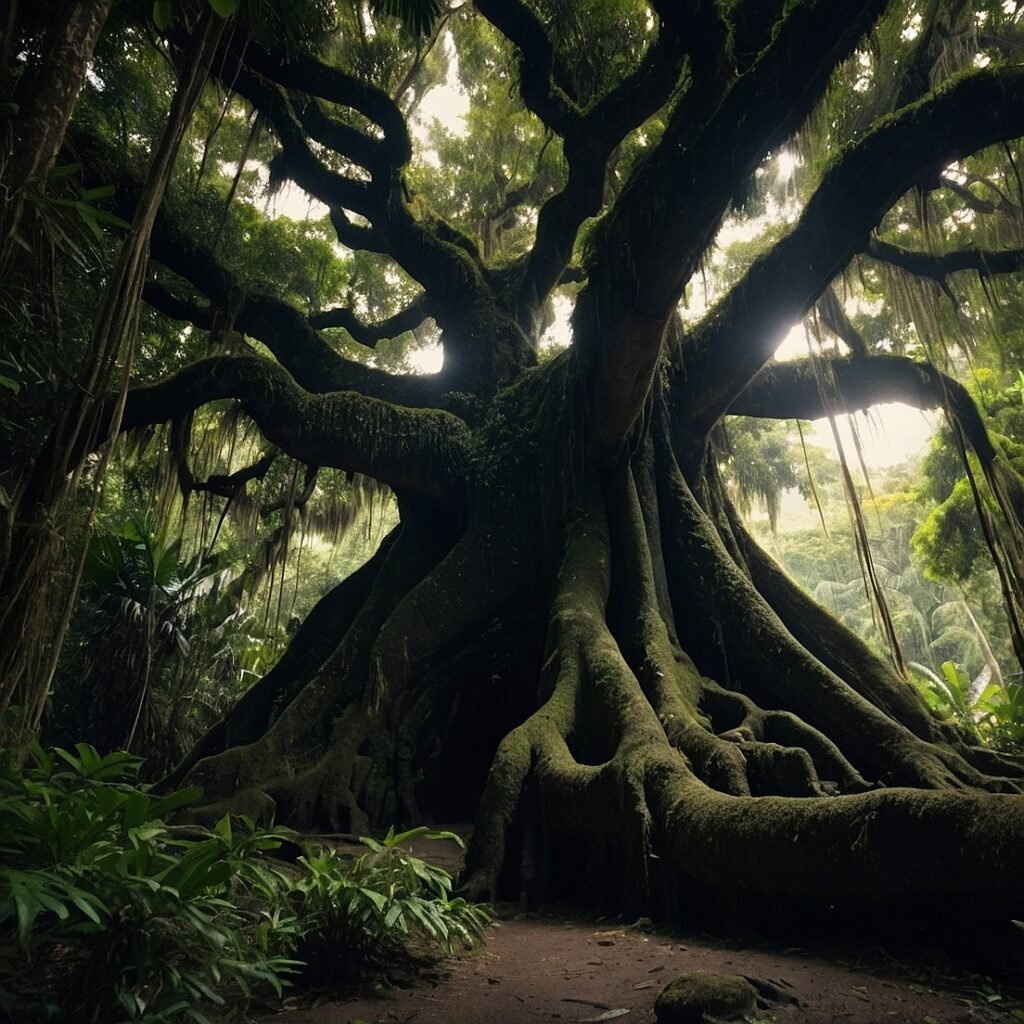The Philippines, an archipelagic nation in Southeast Asia, boasts a rich tapestry of myths and legends that have been passed down through generations. These stories, deeply rooted in the country’s diverse cultural heritage, often feature supernatural beings and mythical creatures that reflect the complex relationship between humans and nature. Among these fascinating entities is the Kataw, a shape-shifting tree spirit that has captivated the imagination of Filipinos for centuries. This blog post delves into the lore surrounding the Kataw, exploring its origins, characteristics, and significance in Philippine folklore.
The Origin and Nature of Kataw
Geographical Distribution
The Kataw is primarily associated with the folklore of the Visayas region in the central Philippines, particularly in the islands of Cebu, Bohol, and Leyte. However, variations of this tree spirit can be found in other parts of the country, each with its own unique attributes and local names. The widespread presence of Kataw-like entities across different Philippine cultures underscores the importance of tree spirits in the nation’s mythological landscape.
Etymology and Linguistic Roots
The term “Kataw” is believed to have originated from the Cebuano language, one of the major languages spoken in the Visayas region. While the exact etymology remains unclear, some linguistic scholars suggest that it may be related to words describing transformation or change, reflecting the spirit’s shape-shifting abilities. The concept of tree spirits is not unique to the Philippines, as similar entities can be found in the mythologies of other Southeast Asian cultures, indicating a shared animistic belief system across the region.
Physical Appearance and Shape-Shifting Abilities
One of the most intriguing aspects of the Kataw is its ability to change its form at will. In its natural state, the Kataw is often described as a ethereal, humanoid figure with features that blend both human and plant-like characteristics. Some accounts depict the Kataw with bark-like skin, leaf-like hair, and eyes that glow with an otherworldly light. However, the true power of the Kataw lies in its shape-shifting abilities, which allow it to assume various forms to interact with or evade humans.
The Kataw in Philippine Folklore
Role as a Guardian of Nature
In many stories, the Kataw is portrayed as a guardian of the forests and natural world. This protective role aligns with the animistic beliefs prevalent in pre-colonial Philippine societies, where spirits were thought to inhabit natural features such as trees, rivers, and mountains. The Kataw’s presence in folklore serves as a reminder of the importance of respecting nature and maintaining harmony with the environment.
Interactions with Humans
Tales of encounters between humans and Kataw often highlight the complex and sometimes unpredictable nature of these spirits. While some stories depict Kataw as benevolent beings that offer guidance or protection to those who respect the forest, others portray them as mischievous or even malevolent entities that punish those who desecrate their domain. These varying accounts reflect the multifaceted relationship between humans and nature in Philippine culture.
Taboos and Rituals Associated with Kataw
The belief in Kataw has given rise to various taboos and rituals observed by communities living near forested areas. These practices often involve seeking permission before entering the forest, making offerings to appease the spirits, or avoiding certain behaviors that might offend the Kataw. Such traditions highlight the continued influence of animistic beliefs on contemporary Filipino culture, even as the country has largely embraced mainstream religions.
Comparative Analysis: Kataw and Other Tree Spirits
To better understand the significance of the Kataw in Philippine folklore, it’s useful to compare it with similar entities from other cultures. The table below provides a comparative analysis of tree spirits from various mythologies:
| Entity | Culture | Characteristics | Role in Folklore |
|---|---|---|---|
| Kataw | Philippine (Visayan) | Shape-shifting, guardian of forests | Protector of nature, sometimes mischievous |
| Dryad | Greek | Female nymph bound to a specific tree | Guardian of trees, symbol of nature’s vitality |
| Kodama | Japanese | Tree spirit, often depicted as small, white humanoids | Indicator of a healthy forest, brings good fortune |
| Green Man | European | Face surrounded by or made of leaves | Symbol of rebirth and the cycle of growth |
| Yakshini | Indian | Female nature spirit associated with trees | Guardian of natural treasures, fertility symbol |
This comparison reveals common themes across different cultures, such as the role of tree spirits as guardians of nature and their connection to the vitality of forests. The Kataw’s unique shape-shifting ability sets it apart from many other tree spirits, adding an extra layer of mystique to its character.
The Kataw in Modern Filipino Culture
Literary and Artistic Representations
In recent years, there has been a resurgence of interest in Philippine mythology, including the lore surrounding the Kataw. Contemporary Filipino authors, artists, and filmmakers have begun incorporating these traditional mythological figures into their works, reimagining them for modern audiences. This trend not only helps preserve cultural heritage but also introduces these fascinating entities to new generations of Filipinos and international audiences.
Environmental Conservation and the Kataw Symbolism
The legend of the Kataw has taken on new significance in the context of environmental conservation efforts in the Philippines. As deforestation and habitat loss continue to threaten the country’s biodiversity, some environmental activists and educators have invoked the image of the Kataw as a symbol of the need to protect and preserve the nation’s forests. By tapping into traditional beliefs and folklore, these initiatives aim to create a stronger emotional connection between people and the natural world.
Tourism and Cultural Preservation
Some regions in the Philippines have begun to incorporate local folklore, including stories of the Kataw, into their tourism offerings. Eco-tourism initiatives that combine nature trails with storytelling sessions about local myths and legends provide visitors with a unique cultural experience while also helping to preserve traditional knowledge. These efforts demonstrate how ancient folklore can be adapted to serve contemporary purposes, bridging the gap between past and present.
Scientific Perspective on the Kataw Legend
While the Kataw is a mythological entity, the beliefs surrounding it can be analyzed from various scientific perspectives. Anthropologists and folklorists study such legends to gain insights into the cultural values, environmental relationships, and social structures of the communities that created and perpetuated these stories. From a psychological standpoint, the concept of shape-shifting spirits like the Kataw may reflect human attempts to understand and rationalize the often unpredictable nature of the natural world.
Ecological Significance of Tree Spirit Beliefs
Environmental scientists have noted that traditional beliefs in tree spirits like the Kataw often correlate with more sustainable forest management practices. Communities that hold these beliefs tend to have a more respectful and conservative approach to resource extraction, viewing the forest as a living entity rather than merely a source of raw materials.
Preserving the Legend: Challenges and Opportunities
Oral Tradition in the Digital Age
One of the primary challenges in preserving folklore like the legend of the Kataw is the shift from oral to written and digital forms of storytelling. While this transition helps document and disseminate these stories more widely, it may also lead to the loss of regional variations and the personal touch that comes with oral storytelling. Efforts to record and preserve different versions of the Kataw legend across various Philippine communities are crucial to maintaining the richness and diversity of this cultural heritage.
Education and Cultural Identity
Incorporating traditional folklore into educational curricula presents both challenges and opportunities. On one hand, it can help strengthen cultural identity and provide students with a deeper understanding of their heritage. On the other hand, educators must navigate the complex task of presenting these stories in a way that respects traditional beliefs while also encouraging critical thinking and scientific understanding.
Balancing Tradition and Modernity
As the Philippines continues to modernize and urbanize, there is a risk that traditional beliefs and folklore may be dismissed as outdated superstitions. However, many cultural experts argue that these legends, including the story of the Kataw, contain valuable wisdom about the relationship between humans and nature. Finding ways to reinterpret and apply this wisdom in contemporary contexts is a key challenge for cultural preservationists and community leaders.
The Enduring Legacy of the Kataw
The legend of the Kataw, the shape-shifting tree spirit of Philippine folklore, continues to captivate and inspire people in the modern era. Far from being a relic of the past, this mythological entity serves as a bridge between traditional wisdom and contemporary concerns, particularly in the realm of environmental conservation and cultural identity. As the Philippines faces the challenges of rapid development and environmental change, the story of the Kataw reminds us of the deep connections between people, culture, and the natural world.
By preserving and reinterpreting these ancient legends, we not only honor the rich cultural heritage of the Philippines but also gain valuable insights that can inform our approach to current global issues. The Kataw, with its ability to change form and adapt, symbolizes the resilience and flexibility needed to navigate the complex relationships between tradition and progress, nature and development.
As we move forward, it is crucial to recognize the value of traditional ecological knowledge embedded in folklore and to find ways to integrate this wisdom with modern scientific understanding. The legend of the Kataw, like many other elements of Philippine mythology, offers a unique lens through which we can examine our place in the world and our responsibilities as stewards of the environment.
In embracing these stories, we not only preserve a vital part of cultural heritage but also open ourselves to new perspectives on sustainability, community, and our relationship with the natural world. The Kataw, guardian of the forests and shape-shifter extraordinaire, continues to inspire and challenge us, reminding us of the magic and mystery that still exists in the world around us.
Disclaimer: This blog post is based on folklore and mythological accounts. While efforts have been made to present accurate information about cultural beliefs and practices, some details may vary across different sources and communities. This content is intended for educational and entertainment purposes only. We encourage readers to approach the topic with respect for diverse cultural perspectives and to conduct further research for the most up-to-date and localized information. If you notice any inaccuracies, please report them so we can promptly make corrections.




